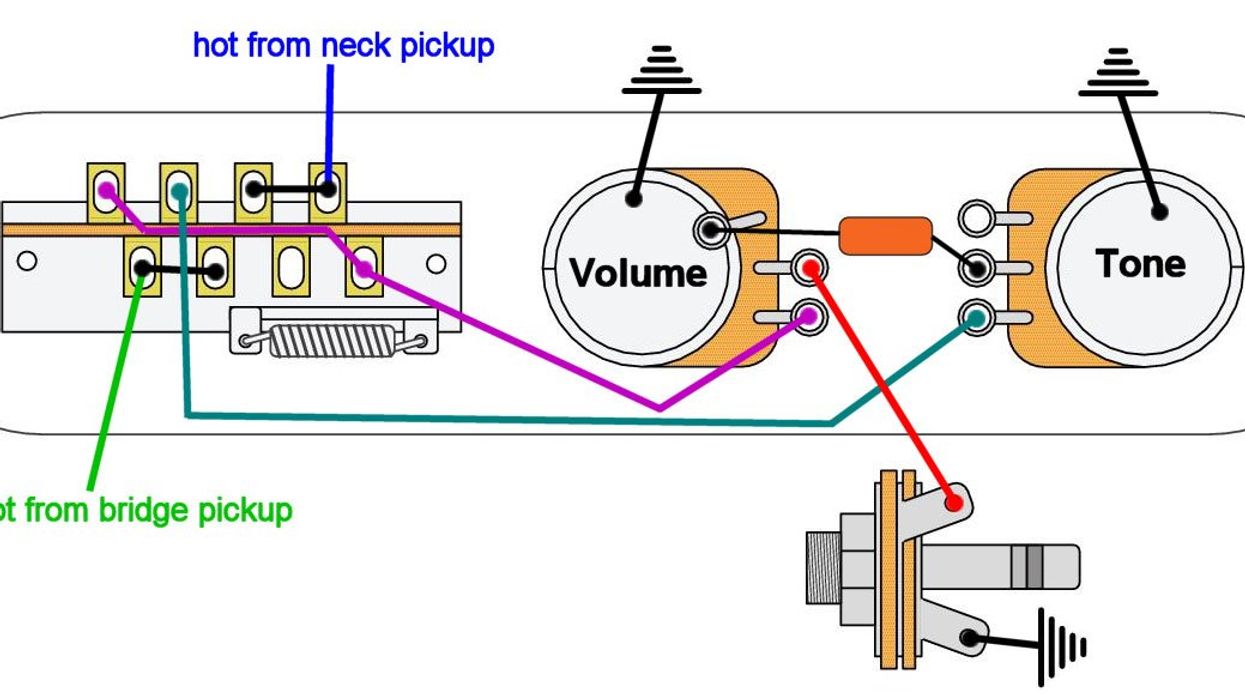Hello and welcome back to Mod Garage. This month, we’ll continue our “no tone control” journey from last month [“Mod Garage: The Scott Henderson S-Style Wiring”] with a cool mod for your Telecaster. Something I hear a lot in the shop is that people aren’t happy with the tone of the neck pickup in their Telecaster. It’s often described as muffled, colorless, lifeless, or similar. Why is this? It’s usually a mixture of three things:
1. The physical location of the neck pickup. You have the same issue on every electric guitar, no matter if it’s a Telecaster, a Stratocaster, a Les Paul, or whatever else. The neck pickup has the warmest tone of them, which is the physical nature of the beast.
2. A standard Telecaster neck pickup has a closed metal cover that’s attached to the pickup’s ground to add some shielding. Because the cover is closed, a good portion of high end will be drained to ground because of eddy currents, even with a thin German silver metal cover.
3. Interestingly, the neck pickup of a Telecaster is often adjusted way too low from the strings for whatever reason. Some players told me that they hit the metal cover with their plectrum, so they adjusted it deeper to get it physically out of the way.
So, let’s see what can be done to address the above problems regarding a Telecaster neck pickup.
Physical location: We can’t outsmart physics and we can’t change the location of the neck pickup inside a Telecaster, so there is nothing we can do here.
Metal cover: We have several possibilities to enhance the tone of the neck pickup. One option is to simply replace the metal cover, which will change the tone noticeably, similar to how moving a carpet or rug away from your amp changes the sound. On the other hand, you lose the shielding abilities of the metal cover. A good compromise is an open-frame pickup cover in the shape of a rectangle with an open top, to break eddy currents. This will enhance the tone while still providing some shielding.
Another solution would be to swap the pickup with a Stratocaster pickup or whatever pickup you like best. But this is not as easy as it sounds. Other pickups have other dimensions, and you will need to reroute the pickup cavity in the body as well as the opening in the pickguard to make them fit. There are a lot of replacement pickguards available that already have such routings for a Strat pickup, so this is not really a problem. A good compromise is a replacement pickup in a Telecaster neck pickup size that offers a different construction under the hood, like the Lollar Royal T Neck that is a Stratocaster-style neck pickup in a Telecaster shape. These are 1:1 ratio replacement pickups, so you don’t have to struggle with new pickguards and routing the Telecaster’s body.
"One option is to simply replace the metal cover, which will change the tone noticeably, similar to how moving a carpet or rug away from your amp changes the sound."
Pickup height: This is super easy to solve: Simply adjust the pickup closer to the strings. The closer the pickup is to the strings, the more high end and volume it will have. We measure the pickup height from the top of the pickup magnet to the bottom of the string while the string is pressed in the last fret with the guitar in playing position. A good starting point for a Telecaster neck pickup is 3.5 mm (9/64") on the low E string and 3.0 mm (1/8") on the high E string. Start with this and listen to what happens when you change the pickup-height adjustment until you find the tone you like best.
I recommend adjusting pickup height first and hear if this does the trick for you. If not, continue with swapping pickup covers or pickups.
As you can see, there are many ways to address the muffled tone of a Telecaster neck pickup if you don’t like it. Here’s another weapon of choice you could try that lies somewhere between the aforementioned strategies. Maybe you adjusted your standard Telecaster neck pickup correctly and now you’re close to being happy with the sound, but it’s still a tad too warm and round for your taste.
Chances are good that this can be solved inside the wiring. Usually, Telecaster players are happy to have a tone control for the bridge pickup that can sound very shrill and ice-picky without one, depending on your playing style and type of bridge pickup. But only a few players really use the tone control for the neck pickup. So how about a wiring with the tone control only affecting the bridge pickup? This way you will get rid of the load of the tone pot (usually 250k) plus the tone cap. Maybe this will give you the tad more high end you’re looking for, so give it a try.
The good news is that you don’t need to change the standard 3-way pickup selector switch like we did on the Stratocaster last month. This is mostly because a regular Tele only has a single master tone control, so we’re happy with the two switching stages of the standard switch you already have in there.
With this wiring, illustrated in Fig. 1, you will end up with these three settings:
1. Bridge pickup with volume and tone control
2. Bridge + neck pickup in parallel with volume for both pickups and no tone control
3. Neck pickup with only volume control
To further enhance this wiring, you can use a no-load pot for the tone control. This way you’ll also be able to engage the bridge pickup without tone control if this is an option you want.
That’s it for this round! Next month, we’ll continue with some Danelectro wirings, so stay tuned.
Until then ... keep on modding!


















![Rig Rundown: AFI [2025]](https://www.premierguitar.com/media-library/youtube.jpg?id=62064741&width=1245&height=700&quality=70&coordinates=0%2C0%2C0%2C0)


















